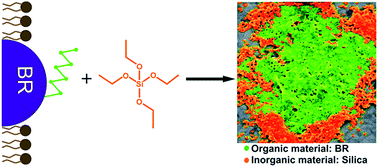Site-selective biomineralization of native biological membranes†
Abstract
Biomineralization of silica precursors, mediated by self-assembled proteins, is performed by many organisms. The silica cell walls of diatoms are perhaps the most stunning biomineral structures. Although the mechanisms of biomineralization are still not fully understood, template-assisted formation of silica nanostructures has gained much attention in the materials science community. Precise control of the location and the shape of structures obtained by biomineralization remains a challenge. This paper introduces a versatile biotechnological process that enables site-selective biomineralization of native biological membranes using genetically modified purple membrane (PM) from Halobacterium salinarum as a template. PM is a two-dimensional crystal consisting of bacteriorhodopsin (BR) and lipids. In this work we study PM-E234R7, a genetically modified PM containing mutated BR, where seven amino acids, starting from E234, were replaced by arginine in the C-terminus. The arginine sequence catalyzes silica formation from a tetraethylorthosilicate (TEOS) precursor. Silicification of the mutated PM variant starts with initial formation of membrane-attached spherical silica nanoparticles, which then fuse to form 2D silica nanoflakes, selectively, on the cytoplasmic side of the PM. Genetical modification of membrane proteins with poly-arginine sequences may be a general route for site-selective biomineralization of native biological membranes.


 Please wait while we load your content...
Please wait while we load your content...